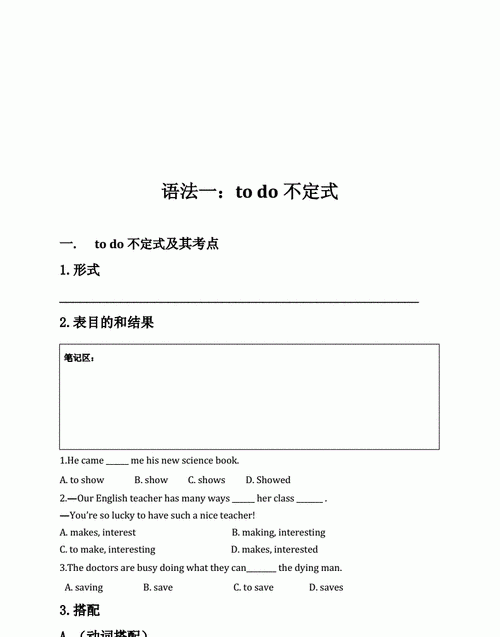本文目录
动词不定式to的用法总结
英语中,把“to do(动词原形)”结构叫做动词不定式。其中to作为小品词用,是动词不定式的标志。但在下列情况下,小品词to会被省略掉。
1、在情态动词及助动词后的不定式不带to。例如:
I can do it myself. 我自己干得了。
Will you please close the window?
请你关上窗户,好吗?
He didn’t go home last night. 昨晚,他没有回家。
2、在see,watch,notice,look at, listen to, hear,feel等感官动词的后面作宾语补足语时。例如:
Did you see him come out of the hotel just now? 你刚才看见他从旅馆出来了吗?
I heard her lock the door. 我听见她锁了门。
但是,上述情况只是出现在主动句中,在被动句中必须带上to。例如:
He was noticed to enter the office. 有人看见他进了办公室。
3、在 make,let,have等使役动词之后作宾语补足语时。例如:
She lets us meet her at the bus station. 她要我们去汽车车站接她。
Don’t make the students do so much homework.. 别让学生做那么多的作业。
与感官动词一样,在被动句中的使役动词必须和带to的不定式连用。例如:
I was made to try it again. 有人要我再试一次。
4、在help后作宾语补足语用的不定式前的小品词to,可带,也可不带。例如:
She helped her mother(to)clean the house yesterday afternoon. 昨天下午,她帮助她母亲打扫屋子。
5、had better后的不定式符号to要省略。例如:
We had better start now. 我们最好立即动身。
You had better not talk in class. 你最好别在课堂上说话。
6、would rather/sooner,rather/sooner than 后的不定式符号to要省略。例如:
We would rather/sooner stay at home. 我们宁可呆在家里。
He prefers to drink some water rather/sooner than drink a coffee.他宁可喝些水,也不愿喝一杯咖啡。
7、“Why not …?”结构中,紧随其后的动词不定式不带to。例如:
Why not ask the man over there?
为什么不那边的这个人?
8、当两个或两个以上的不定式连在一起时,只须在第一个不定式前加to,后面的不定式通常省略to。例如:
I want you to stand beside me and hold the stick. 我想要你站在我身边扶住这根棍子。
He told me to finish my homework and(to)hand it in. 他告诉我完成作业并把它交上去。
9、but 和 except跟在“do + anything/nothing/everything”后面时,通常与不带to的不定式连用。例如:
I could do nothing but lie down.我别无选择,只能躺下。
My pet dog does everything except speak. 我的宠物狗除了不能说话以外,什么事都会做。

不定式to do的用法总结
1. 不定式的用法:
(1)作主语。不定式短语作主语时,为了使句子结构平衡,常将不定式短语放在谓语之后,而用it作形式主语。
It is our duty to give as much help as possible. 提供尽可能多的帮助是我们的职责。
但不定式作表语时,前面有不定式作主语,不定式不可位于句末。
To see is to believe. 眼见为实。
(2)作宾语。常见的只跟不定式作宾语的动词(组)有want, wish, hope, expect, would like (love),care, choose, learn, plan, prepare, mean, agree, promise, offer, refuse, ask, beg, decide, make up one’s mind, be determined, manage, try, can’t afford, fail, pretend等。
①He promised to come today, but he hasn’t turned up yet .
他许诺说今天来,但他到现在还没有出现。
②No one likes to be laughed at. 没人喜欢被嘲笑。
有形容词、分词、名词作宾补,不定式作宾语时要将不定式放于句末,用it 来作形式宾语。如:
You may find it necessary to finish the work ahead of time.
你会发现有必要提前完成工作。
(3)作宾语补足语。常见的跟不定式作宾补的动词有ask, order, advise, like, want, teach, force, forbid, beg, allow, expect, cause, invite, tell, know, call on, depend on, wait for等。
The children asked their parents to take them to the park.。
孩子们要求父母带他们去公园。
感官动词后,如 see, watch, look at, observe, notice, hear, listen to, feel及部分表示“使”、“让”的使役动词,如have, make, let 跟不定式作宾补时要省略不定式符号to。但在被动语态中to 要加上。
Though he had often made his sister cry, today he was made to cry by his sister.
尽管他总是弄哭他妹妹,今天却被妹妹弄哭了。
help后的不定式作宾补(包括作宾语)to 可有可无。
(4)作表语。
My job is to help the patient. 我的工作是帮助病人。
要注意不定式作表语与“be to do”结构的不同:
不定式作表语说明主语的性质或内容,而“be to do”结构表示安排要做的事情。
①My next plan is to draw a picture for the house.(不定式作表语)
我下一个计划是为这座房子画一幅图。
②We are to meet at the school gate at six .(be to do表示安排)
我们约好六点在学校门口见面。
(5)作定语
①表示将来的动作。
The meeting to be held next week will be of great importance.。
下周将要举行的会议极为重要。
② 用在固定搭配中。
I will go to Shanghai tomorrow. Have you anything to be sent to your son?
我明天要去上海,你有什么东西要带给你儿子吗?
(send的动作发出者并非you,因此不定式用被动语态)
注意:作定语的不定式如果与其前面所修饰的名词有逻辑上的动宾关系,然而动词又为不及物动词,动词后要加介词或副词,使其成为及物动词词组。
Will you find me a pen to write with? 你能给我找一支写字的笔吗?
不定式所修饰的词是time, place, way时,不定式后面的介词习惯上要省去。
Do you think it is the best way to deal with such a problem?
你认为这是解决问题的最好方式吗?
(6) 作状语。表示目的、原因、结果。
①They ran over to welcome the guests. 他们跑过去欢迎客人。(目的)
②The child is too young to go to school. 孩子太小不能去上学。(结果)
③We were excited to hear the news. 听到这个消息我们激动了。(原因)
2、不定式的时态
不定式有一般式、进行式、完成式形式,既有主动语态又有被动语态两种语态。形成to do, to be done, to be doing,to have done, to have been done形式。
(1)不定式的一般式所表示的动作通常与谓语的动作(状态)同时(或几乎同时) 发生,或是在它之后发生。
I’m sorry to tell you that you are wrong this time.
我很遗憾告诉你这次是你错了。
(2)如果谓语表示的动作(情况)发生时,不定式表示的动作正在进行, 这时不定式就要用进行式。
I am very glad to be talking with you. 我很高兴与你交谈。
(3)如果不定式的动作发生在谓语动词之前,就要用完成式。
I’m sorry to have kept you waiting for such a long time. 对不起,让你久等了。
注意:不定式的时态一般只能发生在做宾语时。只有在做宾语时,不定式不一定表现为动作未发生,因为此时用不用不定式是由谓语动词决定的,所以才会出现to be doing,to have done这种不合逻辑的现象。(因为to do 表示未发生,have done又表示做过,to have done不合逻辑)
3、不定式的语态
当不定式逻辑上的主语是这个不定式所表示的动作的承受者时, 不定式一般要用被动语态。
He asked to be sent to work in the countryside. 他要求去农村工作。
注意:含有不定式的句子中,能够在句中找不定式动词现成的逻辑上的主谓宾,用主动形式表被动意义。否则,用不定式的被动形式。
句子中有系表结构的,或在句子中可以插入省略掉的(for sb.)形成逻辑上的主谓宾的,用主动形式表被动意义。
例:
It is an honour to be invited to the party.
He gave me some books to read.
The book is easy (for me) to read.
4、疑问词+不定式结构
疑问词who,what,which,when,where和how后加不定式可构成一种特殊的不定式短语。它在句中可以用作主语、宾语、表语和双重宾语。如:
When to start has not been decided.何时动身尚未决定。(主语)
I don’t know what to do.我不知道该怎么办。(宾语)
The difficulty was how to cross the river.困难在于如何过河。(表语)
I can tell you where to get this book.我可以告诉你哪里可以买到此书。(双重宾语)
(注)
A.有时疑问词前可用介词,如:
I have no idea of how to do it.我不知道如何做此事。
B.动词know 后面不能直接跟不定式作宾语,只能跟疑问词(如:how, what)+不定式:
While still a young boy, Tom knew to play the piano well and as he grew older, he wrote operas, the most famous of which is Carmen.

不定式to do的用法举十个例子
动词
不定式
是有表示将来的意思。但是跟所在句子的语态没有关系。在你的这个句子中是表示过去要做某事,要做某事可以说是现在要去做,将来要去做,过去曾经打算要去做的!不定式只是表达要去干嘛的意思,至于是不是将来要去就要看句子的语态。像你举的例子,便是过去的语态。

不定式to do的含义
正确的是There are many interesting things to see and do
这里涉及的语法点,是并列不定式省略to的问题。
当两个或多个作用相同的不定式并列时,通常只需在第一个不定式前用to,其余不定式前的to可以省略。如:
He told me to stay there and wait for him. 他叫我在那儿等他。
It is easier to persuade people than (to) force them.说服人容易,强迫人难。
但是,如果两者有对比关系,则后面的不定式前的to不可以省略。如:
To try and fail is better than not to try at all. 尝试而失败总比不尝试好。

以上就是关于不定式 to do 使用易错点 ,动词不定式to的用法总结的全部内容,以及不定式 to do 使用易错点 的相关内容,希望能够帮到您。

